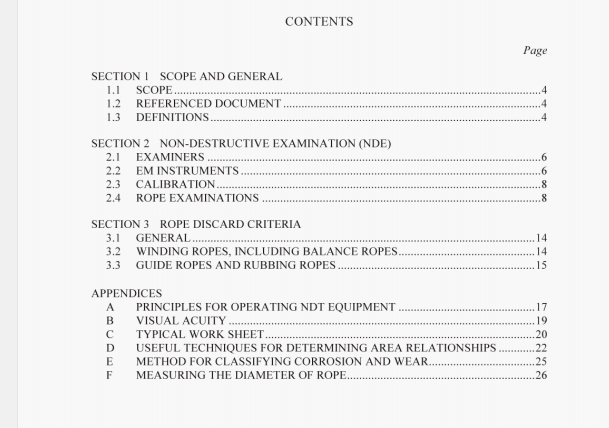AS/NZS 4812:2003 pdf – Non-destructive examination and discard criteria for wire ropes in mine winding systems.
(k) The relationship beteen LMA and loss of actual breaking force may not be necessarily linear or fixed. Conversion factors from LMA to loss of breaking force vary with the type of deterioration in the rope. Care should be taken when attempting to convert LMA into loss of breaking force, especially if there is corrosion within the rope. in extreme cases, it has been found that loss of breaking force can be six times the indicated LMA.
2.3 CALIBRATION
Where any of the following instruments are used during examinations, they shall he calibrated and tested, where applicable, in accordance with any relevant Australian
Standard:
(a) Straight edge or other flatness indicator.
(b) Measuring tape or lay length ruler.
(c) Vernier callipers or micrometer.
(d) Monocular microscope with graduated reticule (see AS 3978).
(e) FM instrument that has traceable calibration records and has been calibrated on an annual basis or as recommended by the manufacturer.
2.4 ROPE EXAIlNATIONS
2.4.1 General
Rope examinations shall include the following sequential processes:
(a) Non-destructively testing a rope using a magnetic instrument, as specilied in Clause 2.4.6.
(b) Visually examining the areas where non-destructive testing has indicated anomalies to exist. as specified in Clause 2.4.7.
All rope measurements and appropriate comments shall be recorded.
2.4.2 Reference values of new rope
Examinations of rope allow changes to be observed, by comparing the rope to an examination made when it was new.
After a newly installed rope has been bedded in. hut before the rope has aged. deteriorated or been damaged in any way, the rope shall be non-destructively tested and the rope diameter and the rope lay length at datum locations shall be measured. Rope diameter shall be measured in accordance with Clause 2.4.8.
The locations of these measurements shall he recorded for future reference. Allowance shall be made for rope crops. which affect the locations of these positions.
2.4.3 Frequency
The frequency of NDFs shall comply with any relevant requirements of the statutory authority. Testing frequencies should be based on expected rope life operating cycles. operating conditions and rope constructions.
The testing frequency should be increased as the rope reaches the end of its useful life (thatis, as it approaches a discard condition) or if significant rope deterioration is detected.
2.4.4Preparation for an examination
Immediately prior to each examination,the examiner shall check that the followingconditions apply:
(a)The examiner and the customer have agreed upon the scope of the examination.
(b)Safe access to the rope and safe operating conditions are provided. This may require
platforms or attachments to be constructed in order to gain safe access to the rope.
(c)The site is safe for an examination.
(d)Site conditions such as water will not affect the examination.
(e)The site is illuminated by an appropriate light source that provides an adequate
intensity and direction of illumination.
(f)Power supply is available to operate the equipment.
(g)Any relevant requirements of the relevant statutory authority are met.
(h)Where required,intrinsically safe equipment is provided. Special exemption to use the standard test equipment may be required (e.g., in coal mines).
i)The examination equipment is calibrated and operating correctly.
AS/NZS 4812:2003 pdf – Non-destructive examination and discard criteria for wire ropes in mine winding systems
